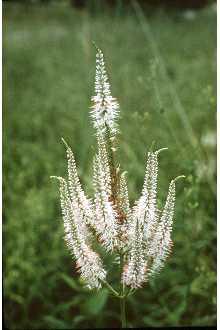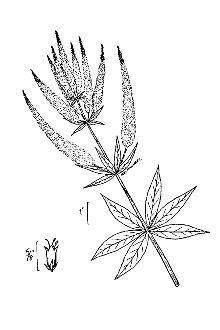Leptandra virginica (L.) Nutt.
Scientific Name: Leptandra virginica (L.) Nutt.

| General Information | |
|---|---|
| Usda Symbol | LEVI12 |
| Group | Dicot |
| Life Cycle | Perennial |
| Growth Habits | Forb/herb |
| Native Locations | LEVI12 |
Plant Guide
Use soil moisture sensors to measure the soil moisture of Leptandra virginica (L.) Nutt..
Fact Sheet
Alternate Names
Bowman’s Root
Uses
Conservation: Culver’s root is a native, clumping, perennial wildflower growing well in moist to wet meadows and prairies. It is a good component of a pollinator seed mixture seeding native grasses and wildflowers together. It grows easily in sunny locations and combines well with wildflowers such as asters, bee balm, cardinal flower, swamp milkweed, goldenrods and ironweeds. Wildlife: The most common visitors to the flowers are long and short tongued bees, which collect pollen and nectar. Other pollinators include honeybees, bumblebees, mason bees, green metallic bees and masked bees. Other insect visitors include sphecid wasps, butterflies, moths and syrphid flies. The seeds are too small to be of interest to birds. Ethnobotanical: The Cherokee, Iroquois, Chippewa and Menominee Indians used this plant for a multitude of medicines. It is used as an analgesic, cathartic (accelerated defecation), emetic (induces vomiting), treatment for coughs, fevers and rheumatism and to assist with childbirth. Landscape: Culver’s root is a tall, durable, adaptable and easily grown. It’s beautiful (usually white, purple to pink) flowers occur at a time of year (July - September) when most other plants are not flowering. It sometimes needs staking and is a good wildflower for meadows, borders, wetlands and rain gardens. It makes a nice cut flower lasting as much as a week in fresh arrangements.
Status
Culvers root is threatened in Massachusetts and New York and endangered in Vermont. Please consult the PLANTS Web site and your State Department of Natural Resources for this plant’s current status (e.g., threatened or endangered species, state noxious status, and wetland indicator values).
Description and Adaptation
Adaptation
Adaptation
Culver’s root distribution from USDA-NRCS PLANTS Database. For updated distribution, please consult the Plant Profile page for this species on the PLANTS Web site. Description: Culver’s root is a native perennial wildflower growing 3 to 6 feet tall. The genus name Veronicastrum is a combination of Veronica and the suffix astrum (false), which describes this plants resemblance to Veronicas. It is one of only two species in the genus. Its common name probably originates from an eighteenth century doctor or herbalist who popularized its use for various ailments. The central stem is round and smooth. Along the stem are 3 to 7 leaves arranged so that all leaves are attached at the same point and wrap around the stem (whorled). These leaves are up to 6 inches long with finely toothed (serrated) edges. At the top of the plant slender spikes of white, pink or blue flowers up to 8 inches long appear from July – September. These flowers, which bloom from the top to the bottom, are not fragrant, last about a month and resemble a candelabrum. The small seeds can be carried by the wind several feet from the mother plant. The root system has a central taproot as well as underground stems (rhizomes).
Establishment
General: The seed capsules are produced in large quantities within the small woody capsules. Collect the capsules when they are yellow, they will turn brown when fully ripe. The seeds do not fall out of the capsules easily and usually have to be slightly crushed (a rolling pin works well) in order for the seed to be released. A very small screen should be used to separate the seed from the chaff. The seed should be stratified before sowing by storing in a sealed, labeled container or plastic bag with wet sand or peat moss at 38 to 40 degrees Fahrenheit for 90 days. Propagation by seeds: After stratifying sow seeds in a soil mix of one-third sand and two-thirds commercial plug mix. Keep the seeds will-lit (light is required for germination) and the air temperature between 60 and 80 degrees Fahrenheit. Germination percentages are usually high (80% range), and seedlings are large enough to transplant by midsummer. Even though Culver’s root is found in damp sunny locations and sometimes wetlands, the greatest threat to seedling survival is overwatering. To establish a native wildflower and grass meadow, sow about 15,000 seed (.2ounces.) per acre with a native seed drill or comparable equipment. Plants grown from seed will flower in their second year. Propagation by cuttings/division: Culver’s root is most easily propagated by divisions in the late fall or early spring. Each rootstock segment must have a bud to be successful. Two to three node tip cuttings (softwood) root easily in the late spring.
Management
It grows slowly for the first year but recovers in the second growing season. Although it is adaptable to growing in various soils and moisture levels, it is not an overly aggressive wildflower. The stems of Culver’s root l may need staking. Pinching back the plants will sacrifice the architectural effect of the foliage.
Pests and Potential Problems
No known or potential problems at this time.
Environmental Concerns
No known environmental concerns. Cultivars, Improved, and Selected Materials Culver’s root is available from nurseries specializing in native plants, ‘Lavender Towers’ is a cultivar with pale purple flowers. .
Prepared By
Shawn Belt, NRCS, Norman A, Use soil moisture sensors to measure the soil moisture of Leptandra virginica (L.) Nutt.., Berg National Plant Materials Center, Beltsville, MD


